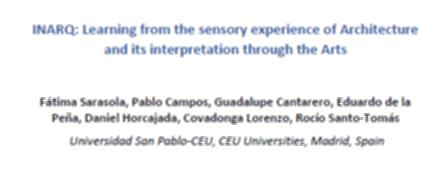Please use this identifier to cite or link to this item:
http://hdl.handle.net/10637/15609INARQ: Learning from the sensory experience of Architecture and its interpretation through the Arts

See/Open:
INARQ_Sarasola_et_al_2023.PNG
10,29 kB
image/png
See/Open:
INARQ_Sarasola_et_al_2023.pdf
Restricted Access
459,16 kB
Adobe PDF
Request a copy
| Title: | INARQ: Learning from the sensory experience of Architecture and its interpretation through the Arts |
| Authors : | Sarasola Rubio, Fátima Campos Calvo-Sotelo, Pablo Cantarero García, Guadalupe De la Peña Pareja, Eduardo Horcajada Díaz, Daniel Lorenzo Cueva, Covadonga Santo-Tomás Muro, Rocío |
| Keywords: | Architectural Interpretation; Graphic abstraction; Perceptive analysis; Teaching&learning innovation; Experience of space |
| Publisher: | Dykinson |
| Citation: | Sarasola, F., Campos, P., Cantarero, G., De la Peña, E., Horcajada, D., Lorenzo, C., & Santo-Tomás, R. (2023). INARQ: Learning from the sensory experience of Architecture and its interpretation through the Arts. En, En Bonilla, M.R., García, M.R., Rey-Stolle, M.F., & Villagrasa, V. Iniciatives to Educational and Teaching Innovation. Madrid: Dykinson, (pp. 352-356). ISBN: 978-84-1170-452-6. |
| Abstract: | The INARQ innovation project was designed and implemented during the first semester of the 2021‐2022 academic year in the Architecture degree, from the subjects of "Form Analysis I" and "Introduction to Architecture" within the framework of the Exploria project. Its main goal was to increase the motivation of the students, enhancing their creative interpretation of the architectural fact. The strategy was based on designing an emotional approach to Architecture from other Arts, in order to encourage its holistic understanding. The initiative also sought to introduce students to the language of theoretical and graphic abstraction as a tool for thought and expression, as well as to enrich their perceptive, analytical, and interpretative skills in their understanding of architecture. Under this innovative approach, the classroom and drawing workshop work was complemented with the study of bibliographic references, on‐site experience (visits to buildings in Madrid), lectures, visits to exhibitions, individual presentations, and critical sessions with other classmates. The activity favoured the existing synergies between both subjects, and the motivation of students and teachers to take on new challenges, proving that learning transcends the physical and temporal framework of the classroom, expanding the regulated spaces and schedules, to promote at the same time the transversal learning based on other Arts as an innovative way of Teaching/Learning. |
| URI: | http://hdl.handle.net/10637/15609 |
| Rights : | http://creativecommons.org/licenses/by-nc-nd/4.0/deed.es |
| ISBN: | 978-84-1170-452-6 |
| Issue Date: | 2023 |
| Center : | Universidad San Pablo-CEU |
| Appears in Collections: | Escuela de Politécnica Superior |
Items in DSpace are protected by copyright, with all rights reserved, unless otherwise indicated.

